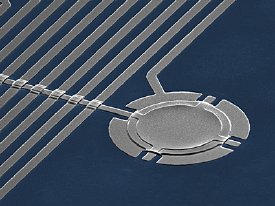Mar 18 2011
Physicists at the National Institute of Standards and Technology (NIST) have demonstrated an electromechanical circuit in which microwaves communicate with a vibrating mechanical component 1,000 times more vigorously than ever achieved before in similar experiments. The microscopic apparatus is a new tool for processing information and potentially could control the motion of a relatively large object at the smallest possible, or quantum, scale.
Described in the March 10 issue of Nature,* the NIST experiments created strong interactions between microwave radiation at a frequency of 7.5 billion beats per second (7,500 megahertz) and a "micro drum" vibrating at radio frequencies of about 11 million beats per second. Compared to previously reported experiments combining microscopic machines and electromagnetic radiation, the rate of energy exchange in the NIST device - the "coupling" that reflects the strength of the connection - is much stronger, the mechanical vibrations last longer, and the apparatus is much easier to make.
 Colorized micrograph of NIST's aluminum drum, which is 15 micrometers in diameter and 100 nanometers thick. The drum is used in quantum information experiments and ultraprecise measurements of mechanical motion. Credit: A. Sanders/NIST
Colorized micrograph of NIST's aluminum drum, which is 15 micrometers in diameter and 100 nanometers thick. The drum is used in quantum information experiments and ultraprecise measurements of mechanical motion. Credit: A. Sanders/NIST
Similar in appearance to an Irish percussion instrument called a bodhrán, the NIST drum is a round aluminum membrane 100 nanometers thick and 15 micrometers wide, lightweight and flexible enough to vibrate freely yet larger and heavier than the nanowires typically used in similar experiments.
"The drum is so much larger than nanowires physically that you can make this coupling strength go through the roof," says first author John Teufel, a NIST research affiliate who designed the drum. "The drum hits a perfect compromise where it's still microscale but you can couple to it strongly."
The experiment is a step toward entanglement - a curious quantum state linking the properties of objects - between the microwave photons and the drum motion, Teufel says. The apparatus has the high coupling strength and low energy losses needed to generate entanglement, he says. Further experiments will address whether the mechanical drumbeats obey the rules of quantum mechanics, which govern the behavior of light and atoms. That would mark a key achievement in NIST's effort to develop components for superconducting quantum computers and quantum simulations, while also working toward the widely sought scientific goal of making the most precise measurements possible of mechanical motion.
The drum also has possible practical applications such as measuring length and force with sensitivities at levels of attometers (billionths of a billionth of a meter) and attonewtons (billionths of a billionth of a newton), respectively.